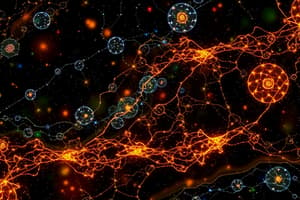Podcast
Questions and Answers
Which of the following is NOT a key element of Lamarck's theory of evolution?
Which of the following is NOT a key element of Lamarck's theory of evolution?
- The environment directly influences the development of organisms.
- Extinction is a natural part of evolution. (correct)
- Organisms pass on acquired characteristics to their offspring.
- Individuals within a population improve over time.
What is the primary difference between Lamarck's and Darwin's theories of evolution?
What is the primary difference between Lamarck's and Darwin's theories of evolution?
- Darwin's theory focused on the improvement of species, while Lamarck's theory focused on the preservation of species.
- Darwin believed in extinction, while Lamarck did not.
- Lamarck believed in the inheritance of acquired characteristics, while Darwin believed in natural selection acting on random variation. (correct)
- Lamarck focused on the complexity of organisms, while Darwin focused on the environment's role.
According to Darwin's theory of evolution, which of the following conditions is essential for natural selection to operate?
According to Darwin's theory of evolution, which of the following conditions is essential for natural selection to operate?
- Organisms must be able to adapt to their environment through conscious effort.
- The environment must be stable and unchanging.
- Variation among individuals must be inheritable. (correct)
- Individuals must possess a strong drive to survive and reproduce.
Why is it difficult to replicate evolution in a laboratory setting?
Why is it difficult to replicate evolution in a laboratory setting?
Which statement best describes Darwin's concept of 'fitness' in the context of evolution?
Which statement best describes Darwin's concept of 'fitness' in the context of evolution?
Which adaptation allows an organism to survive by altering its behavior rather than its physical characteristics?
Which adaptation allows an organism to survive by altering its behavior rather than its physical characteristics?
What is the main premise of creationist thought regarding the features of organisms?
What is the main premise of creationist thought regarding the features of organisms?
Which concept explains the presence of similar structures in organisms of the same taxonomic group due to shared ancestry?
Which concept explains the presence of similar structures in organisms of the same taxonomic group due to shared ancestry?
What term describes features that serve similar functions but evolved separately, indicating no common ancestor?
What term describes features that serve similar functions but evolved separately, indicating no common ancestor?
Which of the following is a limitation noted in the evolution towards perfect adaptation?
Which of the following is a limitation noted in the evolution towards perfect adaptation?
Which study examines the distribution of organisms and the environmental factors influencing that distribution?
Which study examines the distribution of organisms and the environmental factors influencing that distribution?
The study of embryonic development in different species reveals what type of evolutionary evidence?
The study of embryonic development in different species reveals what type of evolutionary evidence?
What does paleontology primarily provide evidence for in the study of evolution?
What does paleontology primarily provide evidence for in the study of evolution?
Flashcards
Organic Evolution
Organic Evolution
Long-term, stable changes in the physical or behavioral characteristics of a group of organisms.
Lamarck's Theory of Evolution
Lamarck's Theory of Evolution
The idea that species do not go extinct, but rather transform into new species under environmental pressure. Individual organisms develop traits based on use or disuse, which are then passed down to their offspring.
Natural Selection
Natural Selection
The process by which organisms with traits better suited to their environment survive and reproduce more successfully, passing on those advantageous traits to their offspring.
Darwin's Theory of Evolution
Darwin's Theory of Evolution
Signup and view all the flashcards
Evolution takes time and patience
Evolution takes time and patience
Signup and view all the flashcards
Evolution
Evolution
Signup and view all the flashcards
Adaptations
Adaptations
Signup and view all the flashcards
Creationism
Creationism
Signup and view all the flashcards
Homologies
Homologies
Signup and view all the flashcards
Analogies
Analogies
Signup and view all the flashcards
Vestigia
Vestigia
Signup and view all the flashcards
Biogeography
Biogeography
Signup and view all the flashcards
Study Notes
Organic Evolution
- Stable long-term change in physical and/or behavioral features of populations
Jean Baptiste De Lamarck
- No extinctions
- Individuals strive to improve complexity and performance
- Use develops organs, disuse wastes them
- Improvements are passed down (e.g., giraffe neck)
Charles Darwin
- New species arise through natural selection
- No inherent improvement or purpose
- Random variability favors the fittest
- Variability must be high and work rapidly
- Heritable variability (genes) must be complete for full transmission
Adaptation
- Organism's fitness to survive in its environment
- Achieved through adaptive skills (physical features, mimicry, camouflage, behavior)
Creationist vs. Evolutionist
- Creationist view: Intelligent design, no evolution
- Evolutionist view: Adaptations develop randomly, natural selection, efficient traits remain, others disappear, accounts for homologies and failed adaptations
Morphology and Homology
- Organisms in the same taxonomic group share similar body structures (homologies)
Analogous Structures
- Structures with similar functions but evolved separately, no common ancestor (convergent evolution)
Vestigial Structures
- Body improvements, but some limits defined by genetic programs from ancestors. (prevents "perfect adaptations") (e.g., whale legs, snake legs)
Biogeography
- Distribution of living organisms
- Influenced by geography, climate, evolutionary history
- Different adaptations based on different environments
Embryology
- Primitive traits appear in the earliest stages of embryo development
Paleontology Evidence
- Fossil record incomplete, showing punctuated equilibrium (rapid bursts of evolution followed by stasis) rather than gradualism.
Studying That Suits You
Use AI to generate personalized quizzes and flashcards to suit your learning preferences.




